Childhood Heroes: storytelling survival strategies and role models of resilience to COVID-19
Funded by a British Academy COVID-19 Special Research Grant (COV19\201444), this project started on 3 August 2020
About this project
The project focuses on storytelling – past and present – and aims to mitigate the immediate and longer-term educational, social and mental health impacts of COVID-19, as well as the marginalisation of children’s voices.
There are two interlinked strands to the project: the first explores historical children’s interaction with classical role-models in early magazines which forged new communities through distanced learning. The second focuses on creative responses to heroic narratives today in light of COVID-19. Researching archival and contemporary material together enables us to understand shifting, but enduring, notions of both heroism and childhood.
In collaboration with Storytime Magazine and underpinned by historical research, we are producing a series of print and digital resources enabling children to make reassuring transtemporal connections with models of survival (see below or download here). These will also be used as prompts to encourage children’s creative responses as a way of facilitating emotional processing.
Via a series of blog posts (above), we will also be documenting some of the many contemporary narratives and resources which address COVID-19, focusing on narratives of heroism.
Principal Investigator: Rachel Bryant Davies
Co-Investigators: Lucie Glasheen; Kiera Vaclavik
Consulting collaborator: Kristin Hadfield
Contact us at: childheroes@qmul.ac.uk
Free children's storytelling and activity resources
Free Mini Children's Magazines
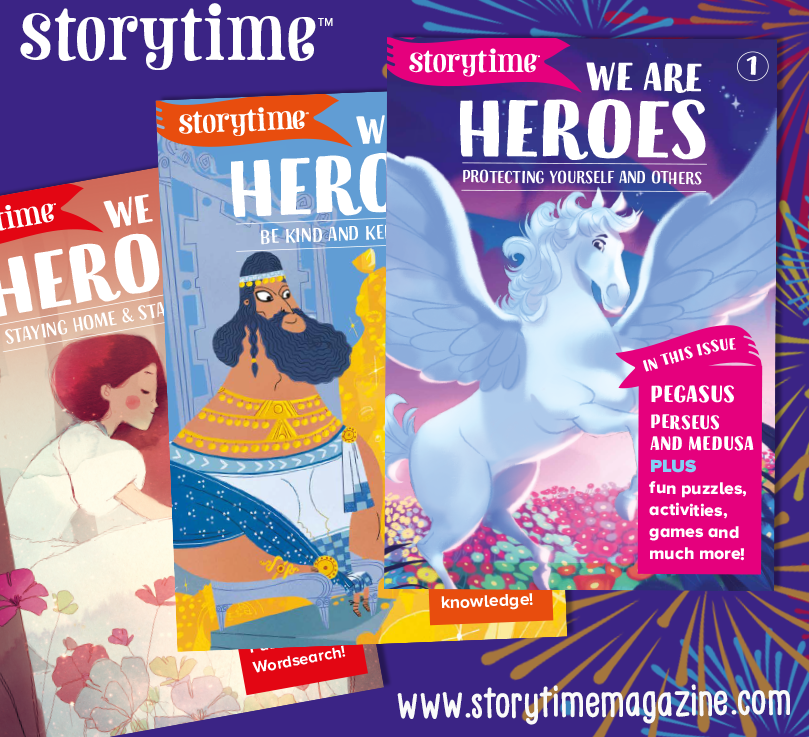
We are delighted to be collaborating with Storytime magazine to produce resources aimed at children from 3-9 years old. 'We Are Heroes' is a series of sixe special issues. Each edition contains carefully chosen stories that have parallels to experiences of lockdown that children could be facing – such as staying at home or protecting yourself – with additional activities to offer children a creative way of processing the current situation they find themselves in.
Storytime published a new edition of 'We Are Heroes' every month from October 2020 through to March 2021: they are free for anybody to download, read and share.
Storytelling and origami video from the British Academy Summer Showcase 2021
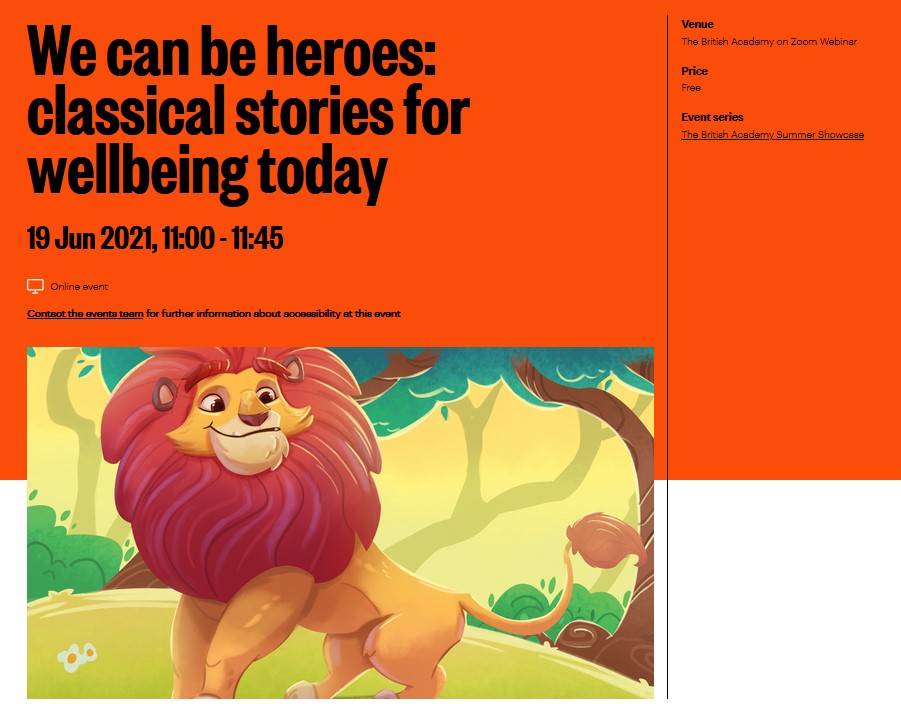
In addition, there is now a video from the British Academy Summer Showcase 2021, featuring performances of two of Aesop's Fables by professional storyteller Wendy Shearer and instructions for making an origami lion and mouse to enact the stories! There is also a special resource pack to accompany the video available from Storytime here.
What can you learn about kindness from a lion? Could a mouse show you how to help a friend in need?
Classical stories have a lot to teach us, from how to help others to showing kindness even when we are afraid. Join our storyteller to hear tales from the Greek and Roman world and learn to make your very own origami lion.
This was a live, free event for children aged 3-9 and their families. Each child (and their adult!) will need two pieces of paper for the simple origami lion and mouse activity. You may also like to have some colouring pens and pencils to decorate your finished lion.

Blog
Childhood heroes: stories for children about COVID-19 in the UK and beyond
A growing number of children’s books, and other texts for children, are being produced in response to the COVID-19 pandemic. They aim to inform and educate children about COVID-19 and/or help with its social and emotional impacts using storytelling.
With the first examples appearing in March 2020, these texts are being created rapidly, and reacting and evolving to advice and policy. Often circulated online for free, sometimes self-published and sometimes translated and adapted multiple times, they are highly ephemeral. As such, they offer snapshots of particular moments in a quickly evolving situation and valuable insights into contemporary ideas about childhood.
This blog, aimed at academics, researchers, practitioners and other interested parties, draws out some of the key issues and themes emerging from COVID-19 children’s literature for future research, including individual and collective heroism, time and temporality and storytelling.
The majority of the texts featured on this blog have been found through the New York City School Library System’s catalogue of COVID-19 Children’s eBooks available on their website to whom we are very grateful.
This blog is run by Dr Lucie Glasheen. If you would like to get in touch please email childheroes@qmul.ac.uk
Ordinary heroism, or the ‘everyday superhero’, became a popular trope during lockdown in the UK.[1] The concept of the everyday hero, often applied to NHS workers, is a nebulous one. This allows it to be expanded, so it can sometimes include waste collectors, cleaners, carers, delivery drivers, supermarket workers, and other ‘key workers’. It can also be applied to the population in general.
This idea of ordinary heroism can be seen in the Scottish anthology Stay at Home! Poems and Prose for Children Living in Lockdown. Stay at Home! was published as a free e-book by the small independent publisher Cranachan in May 2020 and contains a section called ‘Everyday Super Heroes’.
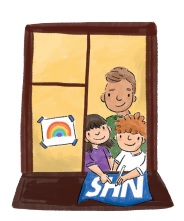
Out of the seven stories and poems in this section, three explicitly mention heroes/superheroes. In all three instances, the ‘superhero’ in question is a woman – the mum or step-mum of the first person narrator.[2]
Figure 1: Darren Gate in Stay at Home! Poems and Prose for Children Living in Lockdown ed. by Joan Haig, Cranachan, 2020, p. 48. Reproduced by kind permission of Darren Gate and Cranachan Publishing.
In Rachel Plummer’s poem ‘Superhero’, the narrator initially describes the ways in which her mum, who ‘doesn’t wear a lycra suit/ or hold a ray gun primed to shoot’, does not meet the typical characteristics associated with a superhero (p. 49). Instead, the protagonist’s mum is a supermarket worker. ‘Super’ is repeated three times in the poem: ‘superhero’, ‘supermarket’ and ‘super empty-shelf-restacker’. This helps to link the ‘ordinary’ and ‘heroic’ roles together, and the poem is emphatic about the importance of supermarket work. It ends by describing the narrator’s mum as ‘the hero, hunger-mender,/ key worker and smile-defender’.
In Yasmin Hanif’s ‘Daisy’s Mum’, the mum in question is similarly a ‘key worker’. Her job is not defined but it involves putting on an ‘outfit, pristine and clean’ to ‘help those unwell’ and she works long hours (p. 56).
In Ross Sayer’s ‘The Game’, in contrast, it appears to be the narrator’s stepmum’s role within the home that is heroic. The narrator’s step-mum is described as ‘the real superhero’ in the very last line of the short story. It is implied that this is because she ‘works on her laptop a lot and has to make dinner and change my little brother’s nappies and do the shopping and take some of the shopping to my gran and do the washing and sort basically everything in the flat’ (p. 55).
In all three texts, but especially in Plummer’s and Sayer’s, there is a juxtaposition between the everyday nature of the tasks being described, both unremarkable and regularly repeated, and their super-heroic nature or impact in light of the pandemic.[3] The texts, and the context that they evoke, elevate the ordinary into the extraordinary.
It is also notable that these heroes are women and are maternal. Heroism, and particular superheroism, has often traditionally been associated with stereotypically masculine attributes such as courage, bravery, endurance and action. However, these texts describe typically feminised activity as heroic. Hanif’s poem emphasises the feminine qualities of Daisy’s mum, describing her as ‘[buzzing] away like a bee’, ‘leaving… her sweet honey smell’ that ‘comforts me’ and with ‘a tired smile’ praising ‘voices that heal’ (p. 55).
Meanwhile, in Sayer’s story the step-mum’s heroism comes from seemingly single-handedly balancing child care and housework with her unspecified employment (an LSE study shows that women ‘are more likely to be taking on extra housework and childcare’ during the pandemic than men). In doing so, ‘Superhero’, ‘The Game’ and ‘Daisy’s Mum’ promote the idea that such tasks and attributes should be valued.
There has, however, been growing criticism about the use of ‘hero’ to describe NHS workers in particular. Esther Murray, Senior Lecturer in Health Psychology at Queen Mary, argues against using heroic tropes for healthcare workers ‘because it makes it look as if people signed up to die, as a hero does, when they didn’t’, as well as making it harder for staff to express how they feel. Jennifer Mathers and Veronica Kitchen have similarly said that heroic narratives suggest that ‘the current situation was inevitable’, allowing criticism of the government’s actions to be deflected, and it has been pointed out that government rhetoric has not necessarily matched their spending or migration policies. Nonetheless, Mathers and Kitchen’s research also shows the value in heroic narratives, arguing that ‘creating and sharing stories about heroes is important for building and maintaining communities’.
The trope of the ‘ordinary hero’ has been used during the twentieth century to advance a range of, sometimes conflicting, political positions. At the moment, the COVID-19 ‘ordinary hero’ narrative, has the potential to either support a return to the pre-COVID status quo or to contribute to a revaluing of care roles. ‘Superhero’, ‘Daisy’s Mum’ and ‘The Game’, and the relationship between all three in the anthology, leave either interpretation open to the reader.
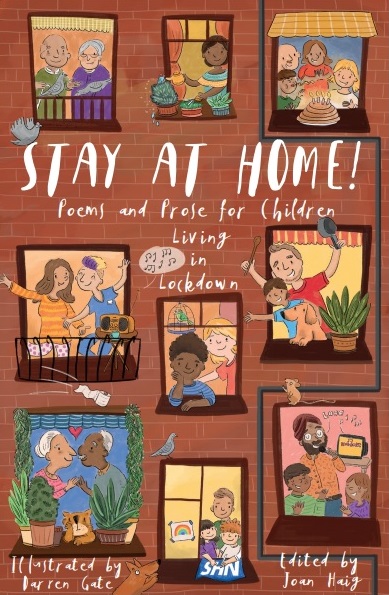
‘Superhero’ by Rachel Plummer, ‘The Game’ by Ross Sayers and ‘Daisy’s Mum’ by Yasmin Hanif in Stay at Home! Poems and Prose for Children Living in Lockdown ed. by Joan Haig, illus. by Darren Gate, Cranachan, 2020.
Image 2: Haig, Stay at Home!, cover. Reproduced by kind permission of Darren Gate and Cranachan Publishing.
[1] This is currently the theme of an exhibition at the Southbank Centre.
[2] The other remaining four texts centre on: a helpful boy called Fergus; a male neighbour associated or identified with Robin Hood; Dot and her Grandmother ‘clapping for’ a gender neutral group of doctors and nurses; and a gender neutral list of ‘farmers and food workers’ and ‘doctors, nurses, cleaners and all angels in disguise’.
[3] There is an established juxtaposition between the ordinary and extraordinary in some superhero characters such as Superman, but in these texts the actions as well as the character move from one to the other.
Lucie Glasheen, September 2020
The first issue of the project’s mini magazine We Are Heroes, produced in collaboration with Storytime magazine, was sent out to selected school subscribers in October. It is now available for free download. As the theme of this first edition is Protecting Yourself and Others, it seemed appropriate for this blog entry to focus on Protection.
While what is considered heroic changes across time and space, a commonly defining characteristic is that of protecting others: from rescuing individuals to defending a community.
The latest UK government information film repeatedly invokes the idea of taking actions to protect others, moving between personal/ proximate and wider conceptions: ‘I wash my hands to protect my family’, ‘I wear a mask to protect my mates’, ‘I wear a mask to protect strangers’, ‘I make space to protect you’. The UK government’s public health messaging has been widely criticised. The effectiveness of this particular campaign, remains to be seen, but it does appear to encourage a sense of community and of active responsibility (if not necessarily heroism) absent from some of the other messages.
So where do children fit into protection narratives? The idea that children need protecting is central to our ideas about what it means to be a child. Children’s studies has shown that children are often constructed as either posing a risk or being at risk (sometimes both at the same time, see Hörschelmann and van Blerk 2012) and how this intersects with class, race, age and space. The protection of children has driven much child legislation. Many academics and practitioners argue that child protectionist narratives have led to the increasing restriction of children’s lives and the undermining of children’s abilities and rights.[1]
Children appear to be far less at risk from COVID-19 than adults and so the protection of children has not become a key narrative.[2] Yet, children, particularly teenagers, and young people have sometimes been cast as themselves a risk or a threat (of spreading the disease), recalling earlier narratives, for instance around children and traffic (which suggested both that children caused traffic accidents and that they were vulnerable to them, Glasheen 2020).
In this binary construction of children as of risk/ at risk, there appears to be little room for imagining children taking on the heroic role of protecting others from COVID-19. Indeed, although the government’s film includes young people, children are completely absent.
However, children’s literature has a long tradition of casting children in heroic or semi-heroic roles, and so in new COVID-19 children’s books we might expect to see children as protectors.
One example of a COVID-19 children’s book which casts children as actively protecting themselves and others against the virus is the Canadian Skownan First Nation picturebook, Nuttah and Kitchi (2020).
Written by Sandra Samatte and illustrated by Julian Grafenauer, Nuttah and Kitchi is a story and journal activity book that can be read for free on flipsnack or downloaded as a pdf via public libraries’ websites. The book is mainly aimed at educating and informing about COVID-19 public health measures, using the framing device of a family living in Skownan First Nation, in Canada, working on ‘Project: Protect Our People’. This is one of a number of children’s books written by Samatte, who works at the Manitoba First Nations Education Resource Centre and lives in Skownan First Nation, including another book featuring the same characters.
The story gives each family member, including four children, Mom, Dad, Grandmother and dog, responsibility for one part of the project. They introduce the reader to that section of information, including ‘Keeping Yourself and Others Healthy and Safe’, ‘Practice Wellness in Your Home’, and ‘Protect Our People’.
This framing suggests that each family member, including children, has an important role to play in protecting those around them. This role is not confined to within the family as the book makes explicit, and transtemporal, links between the family and wider community: the importance of protecting ‘our Elders’ is emphasised as ‘They are our Knowledge Keepers. They have the wisdom we need for now and future generations’. The community is presented as intergenerational (and interspecies). Thus children are presented as neither uniquely vulnerable/risky nor uniquely heroic but able to share expertise and take collective responsibility.
There is far more which could be said about this text and the issues it raises in relation to other COVID-related children’s books, which I hope will picked up here or elsewhere. How the book’s construction of protection relates to Skownan and other First Nations’, as well as the Canadian government’s, narratives of heroism and COVID-19 remains, as far as I am aware, to be explored. When read from the UK, the text provides a vision of how children could be encompassed in protective public health messaging, while also raising important questions about who is included or excluded when ideas of community are invoked.
[1] E.g. Mathew Thomson (2013), Joe L. Frost (2010). Also see Lee Edelman (2004).
[2] At least not from the disease itself. Increasingly there has been focus on the need to protect children from the effects of the pandemic, such as debates about extending the provision of free school meals.
Lucie Glasheen, October 2020
One of the most tangible impacts of the pandemic is the way it has restricted us spatially. In April and May 2020 many countries entered into periods of lockdown. The exact nature of restrictions varied, but there was a collective call to ‘stay at home’. As we saw in September’s blog post a number of children’s books share this message of ‘staying at home’ while also responding to the emotional effect that this may have on children.
One such book is Bird Stays Home by Linda Cartolano and Joanne Raptis, self-published in April 2020 in the US. Bird Stays Home tells the story of a young bird who is told by his ‘Papa Robin’ that they will ‘have to stay home’ so ‘they can stay safe and help other birds stay safe’. It is available as a paperback or ebook for sale on Amazon and as a free YouTube video, in which the book’s pages are displayed and read aloud.
The main way in which this narrative deals with spatial restrictions and their impact is through its use of time. The impacts of the pandemic on time, while less obvious than on space, are important. Psychologist Philip Gale’s recent research suggests that American’s perception of time significantly changed. Anthropologist Felix Ringel states that crises such as COVID-19 cause ‘a feeling of being stuck in the present, combined with the inability to plan ahead’. This, he posits, leads to people ‘tricking time’ by ‘constructing new rhythms and temporal structures’.
Bird Stays Home uses time in three key ways, drawing on tropes of children’s picture books as well as ideas about mental health and wellbeing, in order to facilitate the safe exploration and contextualisation of children’s emotional reactions.
Papa Robin repeatedly tells Bird that they ‘will get through it one day at a time’. In doing so, the book echoes wellbeing advice, including that of the UK government to ‘focus on the present’, and may help the pandemic seem less overwhelming. However, it may also add to the feeling of being unable to look ahead that Ringel discusses.
This phrase is an example of repetition, which is another way in which the book uses time. Repetition of words or phrases is commonly used in young children’s books. It can help teach children to read and new vocabulary, and works well when read aloud as children’s picture books usually are (as in the YouTube video of Bird Stays Home). This oral repetition is also likely to be emphasised through repetition of the act of reading or viewing the book. The repetition in Bird Stays Home (‘It was a …day’; ‘one day at a time’) provides a sense of familiarity. While the pandemic is new, the form in which it is being communicated about is similar to that of other books that children and adults will have read. Repetition can help create structure and routine or it can emphasise a sense of being stuck.
Thirdly, Bird Stays Home charts seven days of staying at home, with different emotions expressed each day. In doing so, the book similarly links a new and potentially distressing situation to the familiar structure of the week. On the final day Bird feels peaceful, invoking Jewish, Christian and Islamic traditions (in which the seventh day of creation is a day of rest). This connects the new experiences of the pandemic to long histories of storytelling, perhaps particularly giving reassurance to the adults who would be buying this book or sharing it with their children.
The week is suggestive of the linear passage of time, and the book reinforces this through the sense that Bird is progressing or developing: by day five Bird is able to comfort himself through mimicking his father. On the other hand, the week also has a cyclical structure as at the end of the seventh day the week will begin again. This cyclical structure may provide its own sense of reassurance that unhappy or frightening emotions will pass. Alternatively, it may undermine any sense of progress or end to the pandemic restrictions.
Experiences of lockdown have been very different for different children (as this month’s We Are Heroes attempts to explore). Since April, when Bird Stays Home was published, we have seen a more uneven spatiality. Most children are less constrained than in April and May, but differences have widened. Both the UK and the US have had localised and changing variations in restrictions, adding to existing inequalities.
Children’s perceptions of time will also have changed as the pandemic has gone on. Some children may no longer remember a time ‘before’, while successive periods of relaxed and tightened restrictions will also change perceptions.
How can and should children’s literature respond? Ringel emphasises the need to move beyond the present to plan for the future. Do the temporal strategies that Bird Stays at Home uses allow for these experiences to be processed and a hopeful future to be imagined? Or does future COVID-19 literature need to come up with different temporal strategies?
Lucie Glasheen, November 2020
I started writing this blog shortly after the UK government announced a last-minute change to Christmas plans. On the 25th November residents of England, Scotland and Wales were told that they could meet up and stay with two other households for five days over Christmas (those visiting households in Northern Ireland were allowed slightly longer for travel). However, on the 19th December a press conference announced that households could only meet up for one day, with the exception of newly designated Tier 4 areas where no mixing was allowed at all.
This announcement would have come too late for books such as Santa’s Christmas with a Mask by Divya Mohan and Hend Moharram, published on 8th November. A number of COVID-19 Christmas-themed books were released leading up to Christmas: my research has identified 18 published in the UK, USA and Ireland [1].
Unlike many of the books published near the beginning of the pandemic, the majority are for sale in paperback (£4.99 - £9.99) or e-book editions (£1.99 - £4.85).
As such, they are less immediately accessible to readers and researchers (including this one). This may paradoxically mean they are more available to future readers and researchers as free web copies and their hosting sites can easily be removed while physical and purchased e-copies have more permanence (although not necessarily – to date I have been unable to locate any library copies).
The texts all sit within a larger field of books (and films, games, toys etc.) whose release is timed to coincide with the lead-up to the festival. Christmas is important commercially and publications may be planned for months, or years, in advance to take advantage of this market. But Christmas-themed narratives also play an important role: building anticipation, creating atmosphere and maintaining, inventing and reproducing traditions.
COVID-Christmas texts share a focus on Christmas being different this year and the need to stay apart. For example, Covid Christmas Parade, written by eight-year old Milan Kumar (2020), opens with ‘Christmas was coming, but James was so sad. This year would be nothing like any he’d had’, James saying ‘Christmas is Christmas when we are together!’. In addressing worries about a changed Christmas, they aim to provide a sense of reassurance that fundamental aspects of the tradition will remain through making reference to familiar figures or tropes. In Kelley Donner’s (2020) A Very Corona Christmas, for instance, Santa wears a red and white PPE suit with a Santa hat. The texts therefore both emphasise the particular and ‘different’ time in which the reader and narrative is situated and the reoccurrence and continuity of elements that make Christmas a special time of year.
It is interesting to note that many of the texts are self-published. As the UK rule changes show, tying publications to a specific time and situation runs the risk of irrelevancy.
Such rapid changes to the rules and guidance governing our behaviour have become relatively common during the pandemic (including just before religious festivals). In the spring of 2020 both World Health Organisation and national government advice changed as scientific knowledge about the virus developed and as resource availability and political opinion shifted. This meant books could quickly become out of date. Texts such as Coronavirus: A Book about Covid-19 for Children (Jenner et al, 2020) were updated and re-released a few months after their initial publication, and others published under copyright licenses allowing adaptation.
COVID-Christmas texts are mostly concerned with the emotional and mental impacts of the pandemic rather than more traditional public health communication. They may, nonetheless, inadvertently encourage rule-breaking or unsafe behaviour or respond to a restriction or danger which no longer exists.
However, the use of self-publishing, and of online publishing of other COVID books, allows for greater risk-taking than a commercial publisher might be prepared for and faster reaction and adaptation. Magazines and periodicals can similarly respond relatively rapidly to changing circumstances. My own research into historical children’s comics uncovered the marking and reaffirmation of seasonal traditions (such as Guy Fawkes) as well as occasional responses to new events such as the depiction of a rent strike (Glasheen 2019) and of blackouts during World War Two [2]. Further research would be needed to establish the significance of COVID-Christmas texts but while these kind of publications run the risk of being out of time, they also have the potential to be timely, responding to the particular experiences of children now.
[1] The place of publication was not always given.
[2] ‘Casey Court’ in Illustrated Chips 1930 – 1939.
Lucie Glasheen, December 2020
Staying at home and staying apart (socially distancing) can be acts of care for others in the context of the pandemic. They can, nonetheless, have an individualising and alienating effect.
‘Home’ has different meanings in different contexts and, as feminist scholars have pointed out, it is not a place of safety for everyone. Public health messaging has often imagined ‘home’ as an interior, closed and private space, at the same time that accelerated reliance on new forms of technology are exposing it as permeable (in ways which may be beneficial and dangerous to children).
As well as worries about the unequal ability to and impact of staying at home, and its impact on mental health and feelings of loneliness, there is concern about the erosion of ‘public life’, the community and the collective.
As this blog has explored, many COVID children’s books aim to help children understand and come to terms with the need to stay at home during periods of lockdown, including through portraying the child as a hero for doing so. However, this narrative can, unintentionally, isolate children from their immediate and wider communities, as can be seen in Even Superheroes Stay Home.
Even Superheroes Stay Home by Jamie McGaw (2020) is a rhyming picture book that can be downloaded as a pdf from his website. According to McGaw’s website, he originally wrote the book for his son, and the text written in second person encourages the reader to identify with the illustrated male protagonist. As with other similar texts, then, this book was written with a specific audience in mind but has since been shared and read worldwide (according to McGaw by over 22 countries).
The book focuses solely the need to stay at home, and the narrative attempts to help children come to terms with this through describing a series of activities that the child protagonist, and reader, can do. Similarly to Stay at Home (see September’s blog), Even Superheroes frames ordinary everyday activities as (super)heroic, including what might be considered leisure activities, such as playing with a sibling and reading, and what might be thought of as domestic chores, such as dog walking and washing up.
In Even Superheroes, the reader is told that playing, cleaning and ‘kind words and strong hugs’ are all heroic tasks that will ‘save the day’, and the book might therefore be seen as part of an important shift towards valuing domestic labour while seeing children as playing a significant role within the household and recognising the unique challenges that lockdown poses to them. While others have criticised the use of heroic metaphors for their military and religious overtones, implying sacrifice and silencing dissent, these aspects are absent from the book which uses the figure of the superhero.
However, as noted above, the construction of these activities as super-heroic suggests that there is an extraordinary aspect to them – perhaps because cleaning and caring come to have meaning temporarily in the face of a pandemic and will go back to being invisible afterwards, or in this instance perhaps because the involvement of children as contributing members of the household, taking responsibility for domestic tasks, is unusual. Elsewhere I have criticised the use of certificates to reward children for ‘staying at home, raising our spirits and making us smile’ as being reductive and separating children from the rest of the household. In a similar way, Even Superheroes singles out the child as having a specific but limited part to play. The (relatively narrow) list of activities restricts the possibilities open to the child reader and suggests that children have little responsibility within the family.
Even Superheroes also provides no context for the need to stay at home, we are simply told ‘when outside is grim…even superheroes stay home.’ This potentially increases the shelf-life of the book beyond the pandemic. Yet it also removes the significance of the child protagonist, and reader’s, actions. There is no sense of a world beyond the home and nuclear family, aside from a telephone call with ‘grandma’. Perhaps in order to avoid scaring the reader, this call is not presented as a way of keeping ‘grandma’ safe. Instead, the protagonist is implicitly praised for their patience in listening when she ‘wants to talk for a while’, with the image showing him in his superhero costume yawning. Aside from the problematic nature of this representation, this reduces child (super)heroism to a set of individual actions that help a few individual (and closely related) people, rather than the wider community.
Narratives have the potential to create imaginative and remote connections to others and to situate individual actions within a collective context. As Even Superheroes shows, however, narratives that focus on enduring restrictions can create the sense that children have limited power and add to an erosion of the public. The next blog will explore some examples of heroism which instead focus on the collective or community.
Lucie Glasheen, January 2021
A recent study that surveyed children about their experiences of the pandemic, suggests that they were particularly concerned with, and affected by, its impact on social relationships, including in relation to community and government.[1] Children also ‘talked about themselves as being active participants in the pandemic…shared ways they have been coping with the situation and…sought solutions to their problems as well as problems within their communities’ (p. 19).
As we saw in January’s blog, this is not always reflected in children’s COVID literature. Use of the hero narrative can individualise children, while focus on the home as ‘a site of safety, [equated] with the household’, can suggest a separation from public life.
Hero narratives can, though, be used to connect individual actions to the wider community as in The Virus-Stopping Champion, a Rwandan picture book published by New-York based non-profit organisation NABU.
Similarly to Even Superheroes Stay Home, The Virus-Stopping Champion features a single unnamed masculine protagonist dressed in a superhero costume. The story is simple but makes a series of connections between the individual, an immediate social circle and the wider community.
Unlike Even Superheroes, the context is made clear at the opening of the story (and in the title and front cover). While avoiding going into medical detail, the text describes ‘a virus’ that is ‘travelling around the world’. This is illustrated by an abstract map with curved lines between personified virus particles. The narrative moves from a generalised discussion to a specific family and a particular child – the protagonist and narrator. This child thinks about an individual response to the virus before considering its effect on their social relationships. The narrator ‘will miss playing with my friends’ and ‘sitting on my Grandpa’s lap’ (p. 9). Whereas communication with a grandparent was seen as a trial in Even Superheroes, in The Virus-Stopping Champion it is valued. At the end of the story the imaginative perspective moves from the personal back out to the global:
I think about how much I love the people in my family. I think about how much I love the people in my street, and my village, and my country. Actually I love everyone in the world! (p. 10).
These shifts in perspective backwards and forwards between the individual and a wider community are echoed in the use of pronouns. The text is written in the first person, making use of significant shifts between ‘I’ ‘you’ and ‘we’. When the protagonist first appears in a superhero costume an individualised and competitive view of heroism is implied. They tell us ‘I want to be the best at helping! I want to be a virus-stopping champion!’ (p. 6).
However, the language and perspective shifts outwards as the narrative continues: ‘I just need to stay at home as much as possible, and so do you, and so do your friends and family…If we all do this, we can stop the virus from traveling.’ The text then moves back to a series of ‘I’s and ‘my’s in order to connect the individual with others.
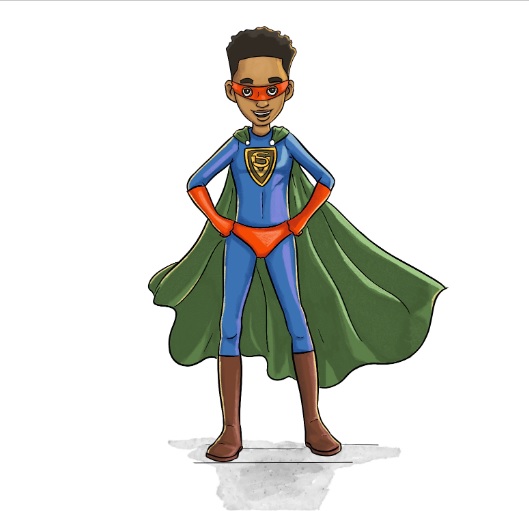
Figure 1: Kevin Ntwali in Hilary Rogers. The Virus-Stopping Champion. Illus. by Kevin Ntwali. NABU, 2020. p. 6. Licensed under Creative Commons Attribution-NonCommercial-NoDerivatives 4.0 International License.
Illustrations emphasise this. The first depiction of the superhero costume shows the protagonist alone on a blank white background. The final illustration shows them standing outside, with both parents in front of a small house. While there are no other people visible, similar houses can be seen in the distance. A road dissects the image diagonally, alluding to the explicitly positive last sentence: ‘My love travels further than the virus’ (p. 10).
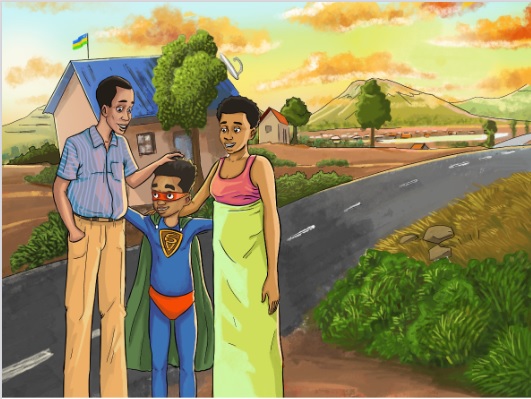
Figure 2: Ntwali, The Virus-Stopping Champion, p. 10. Licensed under Creative Commons Attribution-NonCommercial-NoDerivatives 4.0 International License.
These shifts between the personal, local and global give the actions of an individual meaning and power. While some public health measures may seem small or mundane and others may be difficult, they are made heroic through their ability to save the wider community. This can also help to allay fears: as the reader is given an example of particular actions that can apparently have a wider, potentially global impact. The superhero character that the child takes on is ‘virus-stopping’. Moreover, the narrative suggests that the protagonist, and therefore child reader, is not alone but is part of communal efforts. The figure of the hero is thus used in this story to imaginatively create or sustain a connection to the wider world.
Evocation of community can, however, be repressive and obscure difference. As this narrative moves fluidly between the individual and the wider world, there is little sense of the inequalities that shape experiences of the pandemic, nor (unsurprisingly) of wider structures of decision-making and power.
The above-mentioned study suggests that some children are questioning or challenging the actions of others and government policy. This may particularly be the case amongst certain communities and as the pandemic goes on. It will be interesting to see whether any COVID children’s books will reflect or represent more critical views.
The Virus-Stopping Champion’s depiction is also still that of an individual who participates in public life. In the next blog post I will be looking at examples of collective heroes and thinking about whether they challenge ideas of what heroism is.
[1] This report is based on a survey of 240 children aged 3-12, primarily from the Iceland, Slovenia, the UK and Norway. The survey was conducted between March and August 2020, and the report makes the case for a longitudinal study which would show how children’s expressed concerns change over time.
Lucie Glasheen, February 2021
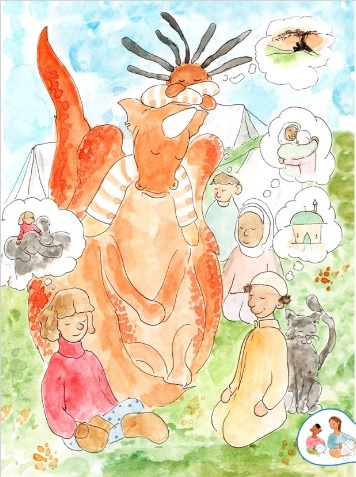
Figure 1: Helen Patuck in Inter-Agency Standing Committee. My Hero is You. Illus. by Helen Patuck. IASC, 2020. Licensed under Creative Commons Attribution-NonCommercial-ShareAlike 3.0 IGO License.
As mentioned in previous blogs, there is growing worry about the impact of the pandemic on social bonds as well as on the mental health of individuals. The initial results of a recent German study suggested that people increasingly feel society is ‘drifting apart’. There is a consensus that social isolation has a negative impact on mental and physical health and a number of international research studies indicate worsening mental illness and distress among children and young people. Experiences vary, some children and young people have reported the benefits of getting to know themselves or others away from their usual social groups, and changes in the provision and accessibility of mental health services also need to be taken into account. However, play campaigners and children’s rights experts point out that lockdown legislation is often discriminatory, socially isolating children more than adults, and detrimental to development.
There are also ethical concerns about social isolation leading to increased individualism and the fragmentation of society, both in the short and longer-term. As we’ve seen public health advice has mainly focused on individual actions, while collective acts (including political protest) have been blamed and criminalised. Although this may to some extent be inevitable in light of a virus that spreads through social contact, such narratives can obscure both the unequal impact of the pandemic and the role of government policy (as well as hinder attempts to hold governments to account).
Kimberley Reynolds (2011, p. 4) argues that what we read as children ‘plays a powerful role in shaping how we think about and understand the world’. I’ve suggested that narratives have the potential to make or sustain imaginative connections with others, even when physical connection is impossible. Can heroic narratives promote collaboration and collective action, or do they necessarily centre an exceptional individual? Can such narratives be used to recognise and build solidarity across diverse pandemic experiences? One story that attempts to promote a collective and diverse version of heroism is My Hero is You.
Many of the books we have looked at so far have represented the experience and necessity of social isolation. In contrast, My Hero is You makes use of fantasy to bring disparate characters together, while still repeating public health distancing advice. The story opens with Sara, a young girl trying to work out how she can face COVID-19 heroically. As she lies in bed worrying, a magical fantastical creature called Ario visits and takes her to visit a number of other children around the world. Sara is joined in her journey by Salem and Leila, who are able to keep distance from one another on Ario’s wings.
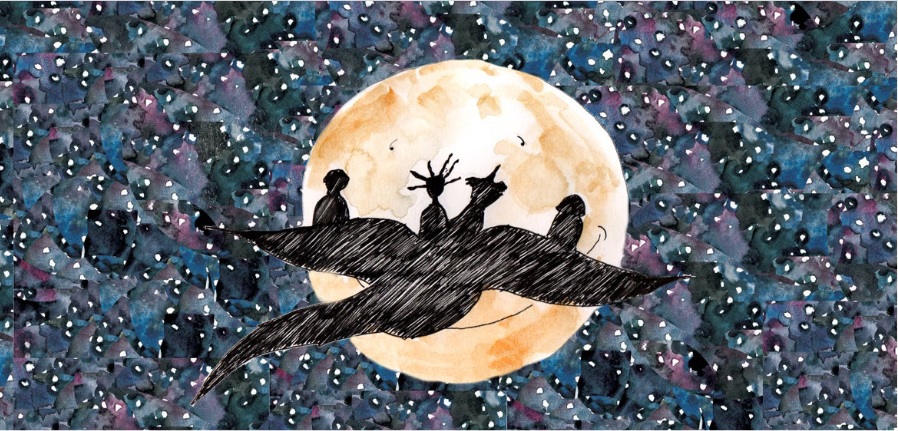
Figure 2: Patuck, My Hero is You. Licensed under Creative Commons Attribution-NonCommercial-ShareAlike 3.0 IGO License.
The figure of Ario allows different children’s experiences to be portrayed (including children living in a refugee camp) and described as heroic. It also enables collaboration, as the different characters, ‘other heroes’, that Sara meets help her and one another. This is exemplified in an illustration showing a group of children all imagining the different places they feel safe. While each imagined place is distinct, the image shows a collective act of imagining. Ario describes the act of imagining as ‘a superpower [that] you can share…with your friends and family’.
The way My Hero is You is written also challenges individualised views. A significant proportion of the text is dialogue. Diversity of representation and of viewpoint is still limited: the language used and thoughts expressed are fairly homogenous throughout. Nonetheless, the text suggests that knowledge formation is a communal and collaborative (although not necessarily collective) act.
This is mirrored in how the story was devised and instructions for reading. My Hero is You was developed by the Inter-Agency Standing Committee Reference Group on Mental Health and Psychosocial Support in Emergency Settings. According to the paratext, the story’s themes came from a global survey and the initial story was refined through feedback from children, parents and caregivers in different countries. Even more than usual, then, the production of the book was a collaborative process and this collaboration is foregrounded. The text was initially published in a number of languages and licensed under a Creative Commons Share Alike license, allowing for it to be easily translated and adapted into different forms.
The supplementary introductory text also explicitly discourages adults from allowing children to read the book ‘independently’. Children’s picture books are nearly always read by adults to children (even if children also read or look at them independently). My Hero is You’s instructions though, when seen in relation to its use of dialogue, foreground reading as a shared act that can build connections, while possibly giving readers and listeners the opportunity to discuss and question aspects of the text.
My Hero is You ends with Sara’s mum telling her that ‘we can all be heroes, everyday, and my biggest hero is you’, a message also be directed to the child listener(s). The text shows that the heroic trope can be used to encompass a variety of experiences and emphasise social connection and solidarity. It is, nonetheless, open to question whether the use of ‘hero’ still suggests a list of individual actions. It is also worth noting that the book is much longer than many of the other texts we have looked at. However, this provides one example of how both experiences of reading and storytelling and narrative content might mitigate or challenge social isolation and fragmentation.
Lucie Glasheen, March 2021
Battle metaphors are ubiquitous in the language of disease. However, Manuela Molina’s COVIBOOK[1] and Charity Tedder’s My Name is Corona[2], two of the first picturebooks about COVID-19 to circulate in early 2020, are examples of an alternative representational strategy. In both picturebooks, the virus that causes COVID-19 (SARS-CoV-2) is personified as a cutesy character, seemingly countering this dominant military rhetoric. A reason to personify the virus as a likeable figure is to make it less scary; to suggest a dialogic rather than antagonistic solution. Young readers acquire a sort of power over the narrative of the pandemic in their lives by giving the virus a voice — but this narrative strategy can still evoke other problematic symbols of disease emergence.
COVIBOOK[1] is a print-out, playable picturebook with colouring-in sections, narrated by SARS-CoV-2, which is represented as a smiling and laughing cartoon microbe. The virus explains that it understands the reader’s fears (‘I would feel the same way’) and goes on to downplay the risk of infection: ‘I don’t stay with people for long, and almost everyone gets better’ (n.p.). Likewise, My Name is Corona[2] depicts SARS-CoV-2 as a population of cute orange characters who simply want to explore the world and never meant to cause harm: ‘I had heard of lots of exciting places across the seas and really wanted to travel the world’ (Figure 1).
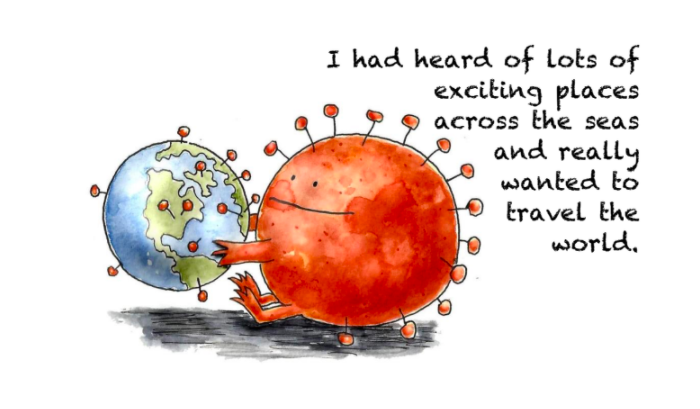
Figure 1: Image from My Name is Corona, reproduced by kind permission of the author.
As with COVIBOOK, the text ends with the virus advising the reader on hand-washing and how to socially distance to prevent further spread. Rather than conceptualizing the virus as an enemy that needs to be destroyed, these texts personify it as a figure or community which never meant to cause harm and which can be reasoned with; essentially, the virus advocates for its own derailing. This characterization may seem silly, but makes an implicit but important point: viruses are not moral objects and have no vendetta.
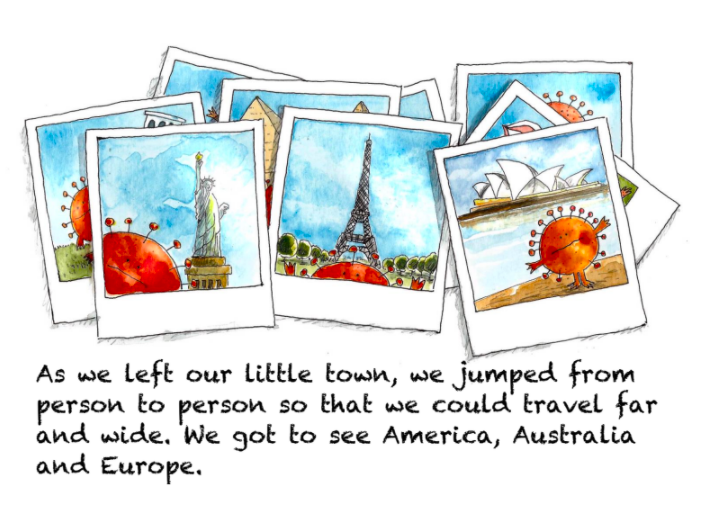
Figure 2: Image from My Name is Corona, reproduced by kind permission of the author.
Although this personification creates space to discuss accurate information about the pandemic in an unemotional way, these narratives remain tied to other archaic tropes of disease as migrant or invader. Priscilla Wald argues that the emergence of new diseases dramatizes ‘the fact, the danger, and the possibilities of human interdependence in a shrinking world’ (9). In COVIBOOK and My Name is Corona, anxieties about the mass movement of people are implicit within the personification of SARS-CoV-2. In COVIBOOK, the virus at first smiles and waves as it holds luggage, superimposed over Planet Earth, suggesting its rapid spread: ‘I love to travel … and to jump from hand to hand to say Hi’. Later, at the end of the text, the virus asks the reader to ‘stop me visiting so many people’ until a vaccine can let it ‘say hi without getting you sick.’ These words are accompanied by a cartoon passport, with the word “APPROVED” stamped across the virus’ face. Images of border control are thus central to the construction of COVID-19, which arguably reinscribes a military connotation.
My Name is Corona opens with a cartoony figure – ‘My name is COVID-19, my friends like to call me Corona’ – who explains its desire to leave ‘a little town in a faraway land’ (n.p.). The faraway land is depicted with Orientalist associations which build throughout the narrative and which entrench an unhelpful causality between COVID-19 and China. The personified virus describes its determination to see the world: because ‘humans would not let me on board their ships or planes’, the virus decided to ‘get into a human’ and jump ‘from person to person’ to enter new countries. The travelogue turns into a plea for forgiveness as the virus discovers the harm it is causing to humans by invading their bodies. It begs to be restricted through a direct address to the reader: ‘WE NEED TO BE STOPPED!’ (n.p.). After offering advice about handwashing and mask-wearing, the virus expresses gratitude: ‘My brothers and sisters and I thank you for helping us from doing more harm’ (n.p.). Using immigration as a metaphor for COVID-19 echoes new and old fears about the interdependence of heterogeneous peoples.
Overall, personifying the virus as a cutesy cartoon character can usefully intervene in the fear and panic that COVID-19 first provoked. The point is not to make the virus seem cute but rather to use cuteness as a means to belittle it and de-hystericize its effect on the world. However, these narratives draw out anxieties about the speed of the modern world and the mass movement of people. Indeed, the depiction of the personified virus as an apologetic and dim-witted foreigner may (for some readers) subtextually echo racist associations. Although these two picturebooks are a tiny and early example of children’s literature about COVID-19, they point to its urgency as an archive. Can we find ways to explain the global spread of COVID-19 which transcend rather than re-entrench ugly and tropes?
References
Wald, Priscilla. Contagious: Cultures, Carriers, and the Outbreak Narrative. Duke UP, 2008.
[1] https://www.mindheart.co/descargables
[2] https://drive.google.com/file/d/1FevOhksly48LpU06slikMd1C0wArYyrF/view
While documenting children’s COVID literature, I have been taken aback by the number of references to superheroes. Visual and textual references to superheroes pepper stories from around the world, as, indeed, has been seen in the previous blog posts. In particular, COVID children’s texts show children as superheroes – on the front cover and/or at crucial moments in the narrative when bravery is required.
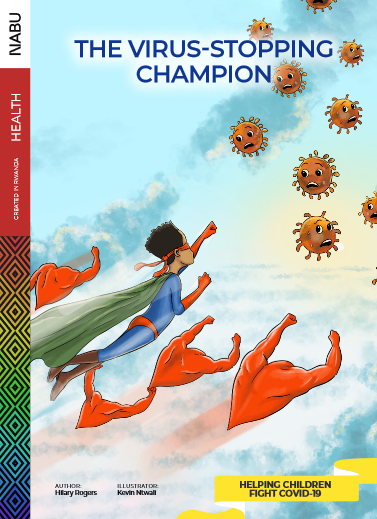
Figure 1: Hilary Rogers. The Virus-Stopping Champion. Illus. by Kevin Ntwali. NABU, 2020. Licensed under Creative Commons Attribution-NonCommercial-NoDerivatives 4.0 International License.
My surprise is probably misplaced. The Marvel superheroes franchise is apparently the ‘highest-grossing franchise of all time’. This includes films and TV series aimed at older audiences but also games, cartoons and toys aimed at younger children. Superheroes can also be found in other cartoons, such as Power Players and Powerbirds in which children and animals are transformed into superheroes, and books such as How to Be a Superhero, Noah’s Superheroes and Superhero Potty, which suggest that children can become superheroes through the performance of certain practices.
Other organisations have also used the figure of the superhero in a wide variety of child-centred campaigns or work. For instance, the Paul Hamlyn Foundation is currently funding the Merseyside-based project Superheroes: Words are our Power, developing creative writing in Primary Schools, Children with Cancer UK has the Mini Superhero Challenge to encourage children to fundraise and Marvel themselves have a documentary and spin-off comic series called Marvel’s Hero Project, which focuses on children as heroes.
The superhero is generally understood to have emerged in American comics at the end of the 1930s (Duncan, Smith and Levitz 2015) and have spread internationally through their trade. In fact, characters with supernatural powers can also be seen in British children’s comics in the late 1930s: both in ‘comic’ cartoon strips such as ‘Hooky’s Magic Bowler Hat’ in the Beano and in illustrated serial stories such as ‘Shade the Shadower’ in Illustrated Chips, and as Chris Gavaler (2017) points out all sorts of literary predecessors could be identified.[1] Nonetheless, it is the American superheroes created and reproduced by Marvel and DC that have come to internationally dominate and shape the superhero genre.
Superheroes and children have not always been viewed positively. In the past there has been anxiety about the impact that superheroes have on children. This reflects their origin in comics and their perpetuation in popular media: comics, film, TV and video games have all been the subject of moral panics at different times during the twentieth century.[2] At the same time, superheroes and comics have been denigrated because of their association with children. Academic research into the figure of the superhero and the superhero genre has exploded in recent years, with studies focusing on disability and death, sexuality and gender, race and racism and nationalism and geopolitics, among others.[3] Initially at least this reconsideration, academically and more broadly, came from focusing on adult-centred media at the expense of looking at superheroes in children’s culture. This is despite the fact that many books about comics or the superhero genre open with the author’s memories of their own childhood encounters.
However, research by psychologists and therapists has pointed out the potential therapeutic benefits of superheroes for children, particularly when used in play therapy. Anne Haas Dyson (1997) similarly looks at how children reproduce and transform superhero narratives. She argues that children’s (re)writing and acting out of superhero stories in a classroom setting revealed their desires and their ‘sense of the social world’ (6). Dyson suggests that children were sometimes able to ‘overcome the ideological constraints of media offerings’ through their active reinterpretation of superhero stories (7).
Gibson et al (2016 p. 2) argue that ‘the diversity of research into superheroes often indicates their chameleon-like qualities’. It is perhaps this capacity for reinvention and re-appropriation, as well as the instant recognisability of the superhero, which makes them so ripe for use in COVID-19 literature (see also Denisen and Mizsei-Ward 2015). At the same time, though, such a capacity draws attention to some of the problems of didactic writing for children. If superheroes are used in so many different contexts, and if children’s play demonstrates reproduction of, resistance to, and reinvention of, superhero ideologies, then uncertainty over the reader’s interpretation is increased. The creators of COVID-19 children’s literature rely on the intertextuality of the superhero to advance their message yet it may be precisely this intertextuality that threatens to undermine it.
Lucie Glasheen, June 2021
[1] E.g. ‘Hooky’s Magic Bowler Hat’, Beano, 7 January 1939, ‘Shade the Shadower’, Illustrated Chips, 20 May 1933.
[2] Kuhn (2002), Lawrence (2006), Thomson (2013).
[3] E.g. Alaniz (2014), Baker and Raney (2007), Buccifero (2021), Dauw (2018), Dittmer (2005), Gavaler (2016), Nama (2011).